Environmental Concern in Rural Andean Communities: Comparative Study in Central Ecuadorian Highlands
Abstract
1. Introduction
2. Materials and Methods
2.1. Study Area
2.1.1. Riobamba
2.1.2. Guaranda
2.2. Study Design
2.3. Sample and Data Collection
2.4. Data Analysis
2.4.1. Confirmatory Factor Analysis (CFA)
2.4.2. Mean Comparison
2.4.3. Structural Equation Modeling (SEM)
3. Results
3.1. Sample Description
3.2. Validity Testing and Confirmatory Factor Analysis (CFA)
3.2.1. Dimensions and Profiles of Environmental Concern in Riobamba
3.2.2. Dimensions and Profiles of Environmental Concern in Guaranda
3.3. Comparison of Environmental Concern Levels Between Riobamba and Guaranda
3.4. SEM Analysis of Environmental Concern Dimensions
4. Discussion
5. Conclusions
Author Contributions
Funding
Institutional Review Board Statement
Informed Consent Statement
Data Availability Statement
Acknowledgments
Conflicts of Interest
References
- Mosquera, G.; Célleri, R.; Wilcox, B.P.; Crespo, P. Progress in understanding the hydrology of high-elevation Andean grasslands under changing land use. Sci. Total Environ. 2022, 804, 150112. [Google Scholar] [CrossRef]
- Mena, P.; Buytaert, W.; Ochoa-Tocachi, B.F.; Crespo, P. Los Páramos del Ecuador: Pasado, Presente y Futuro; USFQ Press: Los Angeles, CA, USA, 2023. [Google Scholar] [CrossRef]
- Rolando, J.L.; Turin, C.; Ramírez, D.A.; Mares, V.; Monerris, J.; Quiroz, R. Key ecosystem services and ecological intensification of agriculture in the tropical high-Andean Puna as affected by land-use and climate changes. Agric. Ecosyst. Environ. 2017, 236, 221–233. [Google Scholar] [CrossRef]
- IPCC. AR6 Synthesis Report: Climate Change 2023. Available online: https://www.ipcc.ch/report/ar6/syr/ (accessed on 25 September 2023).
- Monar, C.; Saavedra, A.K.; Escudero, L.; Delgado, J.A.; Alwang, J.; Barrera, V.; Botello, R. Positive impacts in soil and water conservation in an Andean region of South America: Case scenarios from a US Agency for International Development multidisciplinary cooperative project. J. Soil Water Conserv. 2013, 68, 25A. [Google Scholar] [CrossRef]
- Sales, R.G.; Sousa, A.A.R.; Yáñez, E.; Cano, L.B.; Raffin, D.; Jatar, L.; Astrada, E.; Rubio, M.C.; Aguilera, P.A.; Quintana, R.D.; et al. Degree of importance of demographic and socio-cultural factors in environmental perception: Bases for the design of public policies in Argentina and Spain. Environ. Dev. Sustain. 2024, 26, 9005–9024. [Google Scholar] [CrossRef]
- Oreg, S.; Katz-Gerro, T. Predicting pro-environmental behavior cross-nationally. Environ. Behav. 2006, 38, 462–483. [Google Scholar] [CrossRef]
- Gifford, R.; Nilsson, A. Personal and social factors that influence pro-environmental concern and behaviour: A review. Int. J. Psychol. 2014, 49, 141–157. [Google Scholar] [CrossRef] [PubMed]
- Clayton, S.; Devine-Wright, P.; Swim, J.; Bonnes, M.; Steg, L.; Whitmarsh, L.; Carrico, A. Expanding the role for psychology in addressing environmental challenges. Am. Psychol. 2016, 71, 199–215. [Google Scholar] [CrossRef]
- Lou, X.; Li, L.M.W. The relationship of environmental concern with public and private pro-environmental behaviours: A pre-registered meta-analysis. Eur. J. Soc. Psychol. 2023, 53, 1–14. [Google Scholar] [CrossRef]
- Imaningsih, E.S.; Tjiptoherijanto, P.; Heruwasto, I.; Aruan, D.T.H. Linking of egoistic, altruistic, and biospheric values to green loyalty: The role of green functional benefit, green monetary cost and green satisfaction. J. Asian Finance Econ. Bus. 2019, 6, 277–286. [Google Scholar] [CrossRef]
- Markowitz, E.M.; Goldberg, L.R.; Ashton, M.C.; Lee, K. Profiling the ‘pro-environmental individual’: A personality perspective. J. Pers. 2012, 80, 81–111. [Google Scholar] [CrossRef]
- Ni, L.; Ahmad, S.F.; Alsanie, G.; Lan, N.; Irshad, M.; Bin Saeed, R.H.; Ahmad, A.B.; Khan, Y. Investigating the role of green curriculum in shaping pro-environmental behaviors and environmental values orientation for sustainability. Int. J. Sustain. High. Educ. 2024, 25, 1537–1557. [Google Scholar] [CrossRef]
- Marshall, N.A.; Thiault, L.; Beeden, A.; Beeden, R.; Benham, C.; Curnock, M.I.; Diedrich, A.; Gurney, G.G.; Jones, L.; Marshall, P.A.; et al. Our environmental value orientations influence how we respond to climate change. Front. Psychol. 2019, 10, 938. [Google Scholar] [CrossRef] [PubMed]
- Siddiqi, M.U.A.; Wolters, E.A. Group identities, value orientations, and public preferences for energy and water resource management policy approaches in the American West. Soc. Nat. Resour. 2023, 36, 1302–1323. [Google Scholar] [CrossRef]
- Zheng, L.; Zhang, R. Pro-environmental behaviors and environmental value orientation of vocational college students in China. Sustainability 2024, 16, 9694. [Google Scholar] [CrossRef]
- Berenguer, J.; Corraliza, J.A.; Martin, R. Rural-urban differences in environmental concern, attitudes, and actions. Eur. J. Psychol. 2006, 21, 128–138. [Google Scholar] [CrossRef]
- MAATE. Plan de Acción Nacional para la Conservación, Restauración y Uso Sostenible de Páramos. Available online: https://www.ambiente.gob.ec/wp-content/uploads/downloads/2023/11/PLAN-DE-ACCION-NACIONAL-PARA-LA-CONSERVACION-RESTAURACION-Y-USO-SOSTENIBLE-DE-LOS-PARAMOS.pdf (accessed on 11 September 2024).
- Ciavattone, D. Bridging Knowledge Systems in the Peruvian Andes: Plurality, Co-Creation, and Transformative Socio-Ecological Solutions to Climate Change. 2023. Available online: https://digitalcollections.sit.edu/capstones (accessed on 4 February 2025).
- INEC. Censo de Población y Vivienda Ecuador. Available online: https://www.ecuadorencifras.gob.ec/institucional/home/ (accessed on 23 March 2025).
- Secretaría Técnica Ecuador. Estrategia Nacional Ecuador Crece sin Desnutrición Infantil. 2023. Available online: https://www.infancia.gob.ec/wp-content/uploads/downloads/2023/11/BasePoliticaNov2023V16FINAL.pdf (accessed on 3 April 2025).
- Rivera, J.; Olarte, S. The evolution of child malnutrition in Chimborazo: Between progress and challenges. La Cienc. Al Serv. De La Salud Y La Nutr. 2020, 11, 1–11. [Google Scholar]
- Plan de Desarrollo y Ordenamiento Territorial del Cantón Guaranda 2020–2025. Available online: https://www.guaranda.gob.ec/newsiteCMT/plan-de-desarrollo-y-ordenamiento-territorial-2020-2025/ (accessed on 26 May 2025).
- Plan de Desarrollo y Ordenamiento Territorial del Cantón Riobamba 2023–2025. Available online: https://www.gadmriobamba.gob.ec/index.php/la-municipalidad/la-alcaldia/plan-de-desarrollo-y-ordenamiento/pdot-2023-2035 (accessed on 26 May 2025).
- Sothmann, J.N.; Menzel, S. A Scale for Differentiating Affective and Cognitive Nature Connection Dimensions, Externally Validated in Terms of Self-Transcendence and Environmental Concern. Int. J. Environ. Sci. Educ. 2017, 12, 1847–1869. [Google Scholar]
- Beery, T.H. Establishing reliability and construct validity for an instrument to measure environmental connectedness. Environ. Educ. Res. 2013, 19, 81–93. [Google Scholar] [CrossRef]
- Schultz, P.W. The structure of environmental concern: Concern for self, other people, and the biosphere. J. Environ. Psychol. 2001, 21, 327–339. [Google Scholar] [CrossRef]
- Waris, I.; Iqbal, A.; Ahmed, R.; Hashim, S.; Ahmed, A. Values and information publicity shape tourists’ intentions to visit green hotels: An application of the extended value-belief norms theory. Manag. Environ. Qual. 2024, 35, 780–798. [Google Scholar] [CrossRef]
- Jacobs, T.P.; McConnell, A.R. Gratitude letters to nature: Effects on self-nature representations and pro-environmental behavioral intentions. J. Environ. Psychol. 2024, 96, 102319. [Google Scholar] [CrossRef]
- R Core Team. R: A Language and Environment for Statistical Computing. R Foundation for Statistical Computing. Available online: https://www.r-project.org/ (accessed on 7 April 2025).
- Enders, C. Applied Missing Data Analysis; The Guilford Press: New York, NY, USA, 2010; Available online: https://pzs.dstu.dp.ua/DataMining/preprocessing/bibl/enders.pdf (accessed on 12 February 2025).
- Schultz, P.W.; Gouveia, V.V.; Cameron, L.D.; Tankha, G.; Schmuck, P.; Franěk, M. Values and their relationship to environmental concern and conservation behavior. J. Cross-Cult. Psychol. 2005, 36, 457–475. [Google Scholar] [CrossRef]
- Morata-Ramírez, M.Á.; Holgado-Tello, F.P. Construct validity of Likert scales through confirmatory factor analysis: A simulation study comparing different methods of estimation based on Pearson and polychoric correlations. Int. J. Soc. Sci. Stud. 2013, 1, 1. [Google Scholar] [CrossRef]
- Rosseel, Y. lavaan: An R package for structural equation modeling. J. Stat. Softw. 2012, 48, 1–36. [Google Scholar] [CrossRef]
- Bentler, P.M. Comparative fit indexes in structural models. Psychol. Bull. 1990, 107, 238–246. [Google Scholar] [CrossRef] [PubMed]
- Tucker, L.R.; Lewis, C. A reliability coefficient for maximum likelihood factor analysis. Psychometrika 1973, 38, 1–10. [Google Scholar] [CrossRef]
- Steiger, J.H. Structural model evaluation and modification: An interval estimation approach. Multivar. Behav. Res. 1990, 25, 173–180. [Google Scholar] [CrossRef] [PubMed]
- Jöreskog, K.G.; Sörbom, G.D. LISREL V: Analysis of Linear Structural Relationships by the Method of Maximum Likelihood; National Educational Resources: Chicago, IL, USA, 1981. [Google Scholar]
- Kline, R.B. Principles and Practice of Structural Equation Modeling, 4th ed.; The Guilford Press: New York, NY, USA, 2015. [Google Scholar]
- Hair, J.F.; Black, W.C.; Babin, B.J.; Anderson, R.E. Multivariate Data Analysis, 8th ed.; Cengage Learning: Andover, UK, 2019. [Google Scholar]
- Laroche, F.; Froidevaux, J.; Larrieu, L.; Goulard, M. Structural equation models for the study of ecosystems and socio-ecosystems. In Statistical Approaches for Hidden Variables in Ecology; Wiley: Hoboken, NJ, USA, 2022; pp. 203–227. [Google Scholar] [CrossRef]
- Chao, C.M.; Yu, T.K.; Yu, T.Y. Understanding the factors influencing recycling behavior in college students: The role of interpersonal altruism and environmental concern. Int. J. Sustain. High. Educ. 2023, 24, 969–985. [Google Scholar] [CrossRef]
- Stern, P.C.; Dietz, T.; Kalof, L. Value orientations, gender, and environmental concern. Environ. Behav. 1993, 25, 322–348. [Google Scholar] [CrossRef]
- Gudynas, E. Buen vivir: Germinando alternativas al desarrollo. ALAI 2011, 462, 1–20. Available online: https://www.flacsoandes.edu.ec/en/agora/buen-vivir-germinando-alternativas-al-desarrollo (accessed on 20 March 2025).
- MAATE. Establecimiento y delimitación del Área de Protección Hídrica Quinllunga San Simón–Guaranda; Ministerio del Ambiente, Agua y Transición Ecológica: Guaranda, Ecuador, 2021.
- Voulvoulis, N.; Arpon, K.D.; Giakoumis, T. Systems thinking as a paradigm shift for sustainability transformation. Glob. Environ. Change 2022, 75, 102544. [Google Scholar] [CrossRef]
- Vásquez Bustamante, J.P.; Orellana Yáñez, J.; Rodríguez Teixeira, J. Del Sumak Kawsay al debate por el Buen Vivir: Significados en disputa y disputa por los significantes. Si Somos Am. 2021, 21, 120–145. [Google Scholar] [CrossRef]
- Perreault, T.; Green, B. Reworking the spaces of indigeneity: The Bolivian ayllu and lowland autonomy movements compared. Environ. Plan. D 2013, 31, 43–60. [Google Scholar] [CrossRef]
- Mazzocchi, F. A deeper meaning of sustainability: Insights from indigenous knowledge. Anthropocene Rev. 2020, 7, 77–93. [Google Scholar] [CrossRef]
- Swiderska, K.; Argumedo, A.; Wekesa, C.; Ndalilo, L.; Song, Y.; Rastogi, A.; Ryan, P. Indigenous peoples’ food systems and biocultural heritage: Addressing indigenous priorities using decolonial and interdisciplinary research approaches. Sustainability 2022, 14, 11311. [Google Scholar] [CrossRef]
- Guardiola, J.; García-Quero, F. Buen Vivir (living well) in Ecuador: Community and environmental satisfaction without household material prosperity? Ecol. Econ. 2014, 107, 177–184. [Google Scholar] [CrossRef]
- Scoville-Simonds, M. Climate, the Earth, and God—Entangled narratives of cultural and climatic change in the Peruvian Andes. World Dev. 2018, 110, 345–359. [Google Scholar] [CrossRef]
- Milfont, T.L.; Duckitt, J. The Environmental Attitudes Inventory: A Valid and Reliable Measure to Assess the Structure of Environmental Attitudes. J. Environ. Psychol. 2010, 30, 80–94. [Google Scholar] [CrossRef]
- Tam, K.-P.; Milfont, T.L. Towards Cross-Cultural Environmental Psychology: A State-of-the-Art Review and Recommendations. J. Environ. Psychol. 2020, 71, 101474. [Google Scholar] [CrossRef]
- Ministerio de Agricultura, Ganadería, Acuacultura y Pesca (MAGAP). La Política Agropecuaria Ecuatoriana: Hacia el Desarrollo rural Sostenible 2015–2025; MAGAP: Quito, Ecuador, 2016. Available online: https://www.competencias.gob.ec/wp-content/uploads/2021/03/01-06PPP2015-POLITICA01.pdf (accessed on 20 March 2025).
- Bebbington, A.; Abramovay, R.; Chiriboga, M. Social Movements and the Dynamics of Rural Territorial Development in Latin America. World Dev. 2008, 36, 2874–2887. [Google Scholar] [CrossRef]
- Voulvoulis, N.; Arpon, K.D.; Giakoumis, T. The EU Water Framework Directive: From Great Expectations to Problems with Implementation. Sci. Total Environ. 2017, 575, 358–366. [Google Scholar] [CrossRef] [PubMed]
- Observatorio del Gasto Público. La Inversión Pública En Ecuador Va a Paso Lento. Available online: https://www.gastopublico.org/informes-del-observatorio/la-inversion-publica-en-ecuador-va-a-paso-lento (accessed on 25 May 2025).
- MAG. Informe Ejecutivo de Rendición de Cuentas. Periodo 2023. Quito, Ecuador, 2023. Available online: https://www.agricultura.gob.ec/wp-content/uploads/downloads/2024/03/MAG-Informe-Rendicion-de-Cuentas-2023.pdf (accessed on 25 May 2025).
- Andes Resilientes. Los Saberes Ancestrales de Mujeres Rurales Frente al Cambio Climático Como Potenciadores de Políticas Para la Agricultura Familiar Campesina. 2022. Available online: https://andesresilientes.org/wp-content/uploads/2022/11/Saberes-ancestrales-de-mujeres-rurales-frente-al-cambio-climatico-como-potenciadores-de-politicas-para-la-agricultura-familiar-campesina-.pdf (accessed on 25 May 2025).
- Toledo, L.; Salmoral, G.; Viteri-Salazar, O. Rethinking agricultural policy in Ecuador (1960–2020): Analysis based on the water–energy–food security nexus. Sustainability 2023, 15, 12850. [Google Scholar] [CrossRef]
- Hanspach, J.; Abson, D.J.; French Collier, N.; Dorresteijn, I.; Schultner, J.; Fischer, J. From trade-offs to synergies in food security and biodiversity conservation. Front. Ecol. Environ. 2017, 15, 489–494. [Google Scholar] [CrossRef]
- Nagy, S. The Impact of Socio-Demographic Variables on Pro-Environmental Behaviour. Period. Polytech. Soc. Manag. Sci. 2024; in press. [Google Scholar] [CrossRef]
- Yarosh, J.H. Does racial and gender bias shape perception: Examining how other’s pro-environmental behaviors are viewed. Environ. Sociol. 2024; in press. [Google Scholar] [CrossRef]
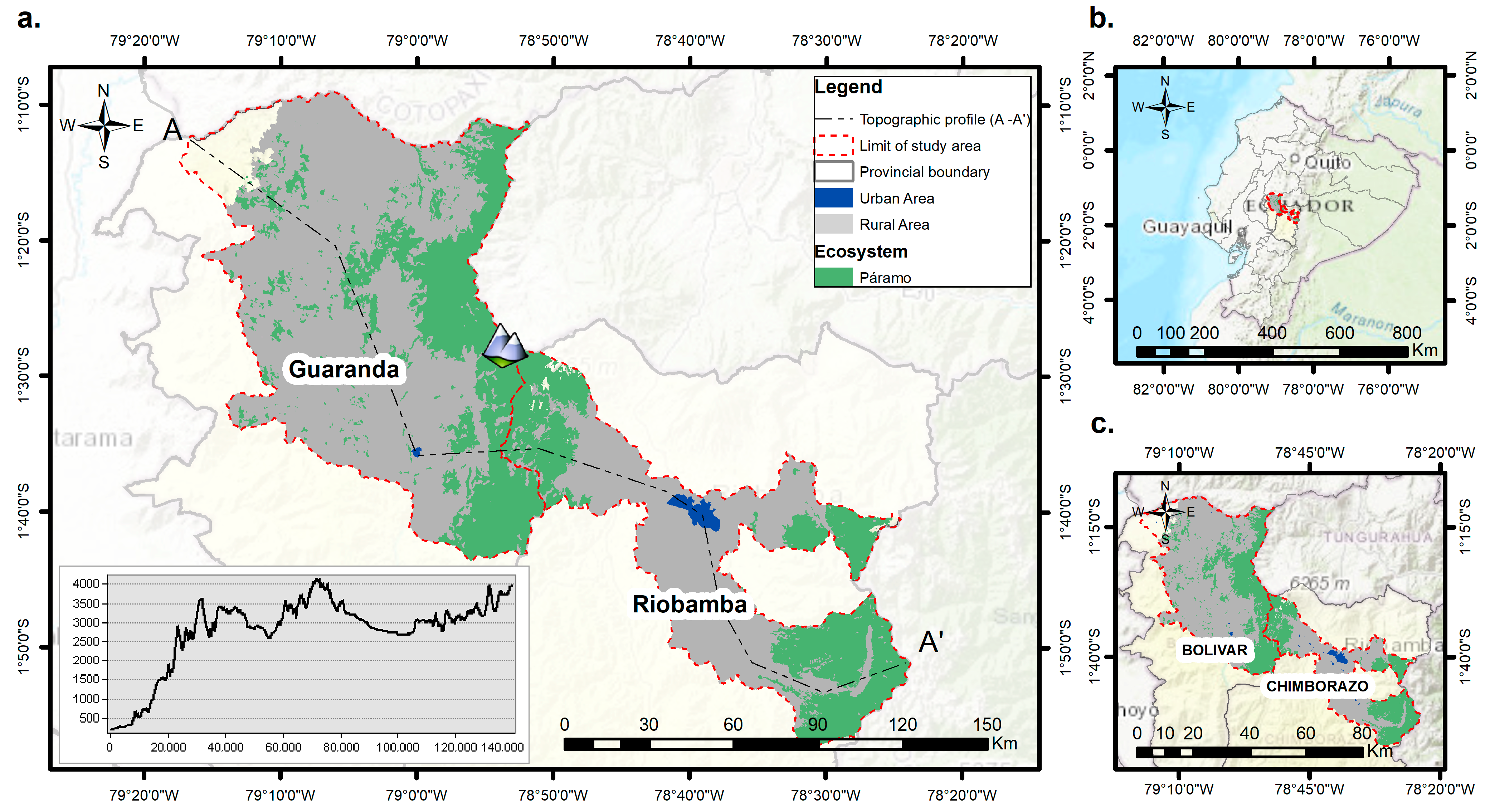
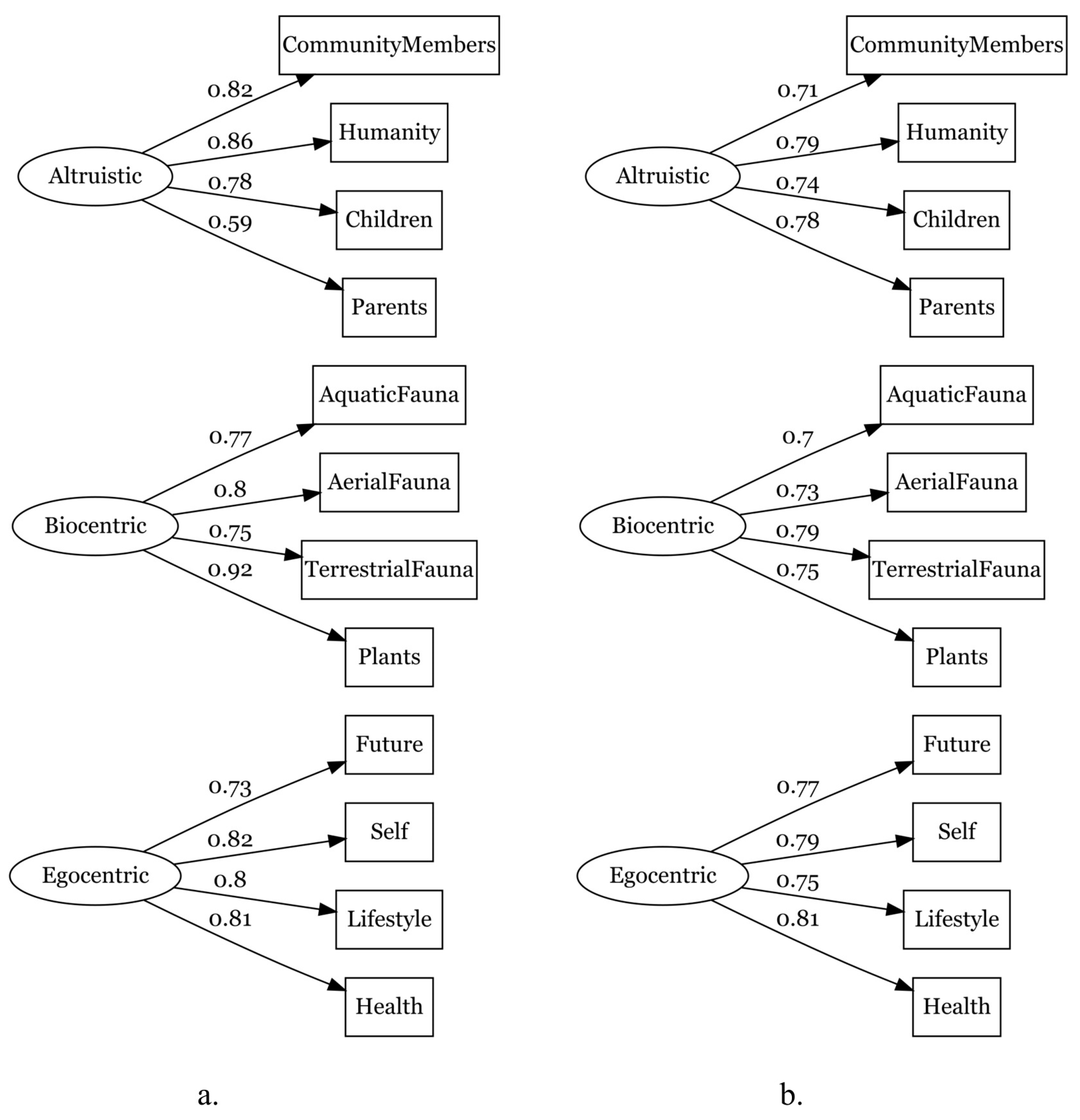
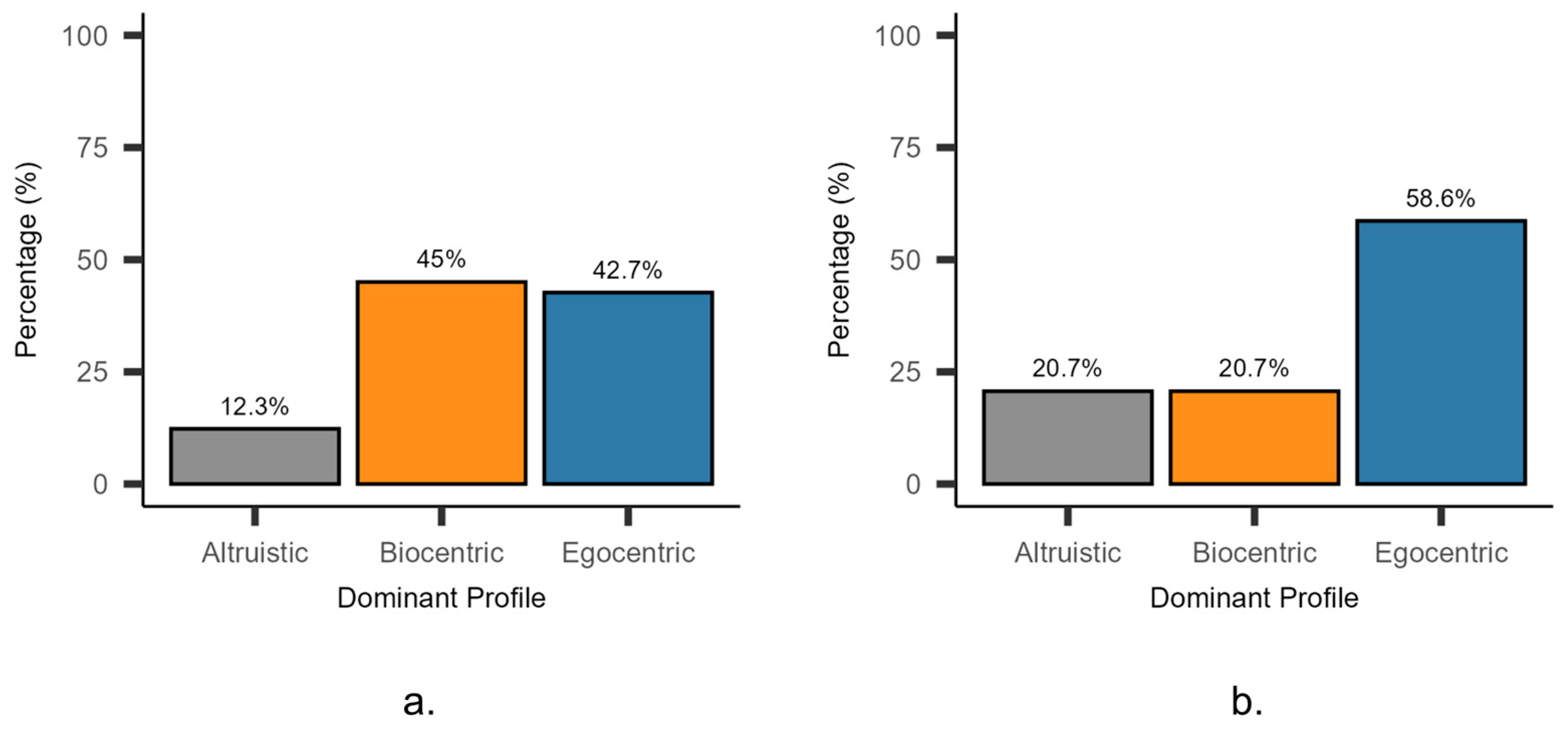
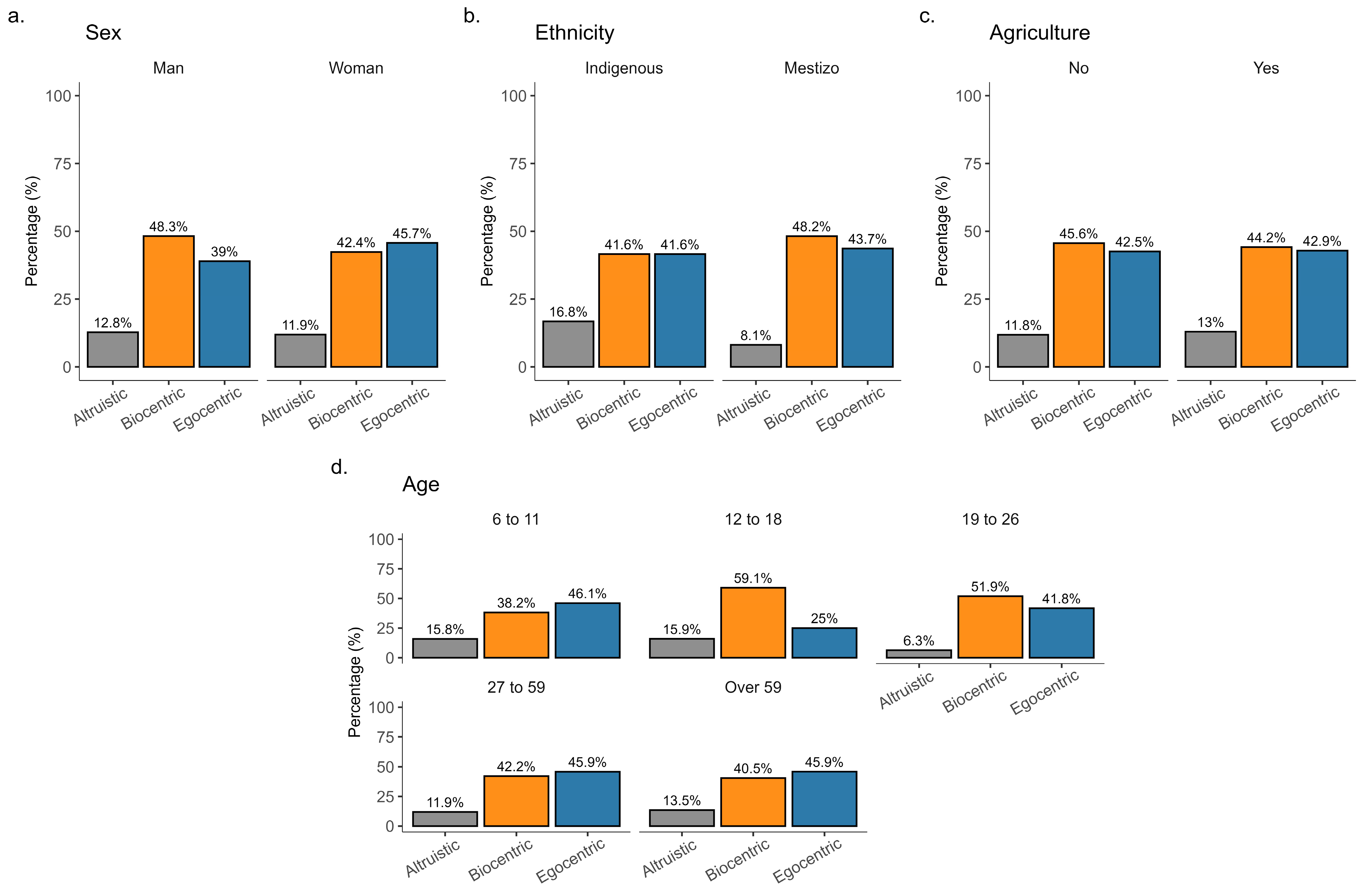
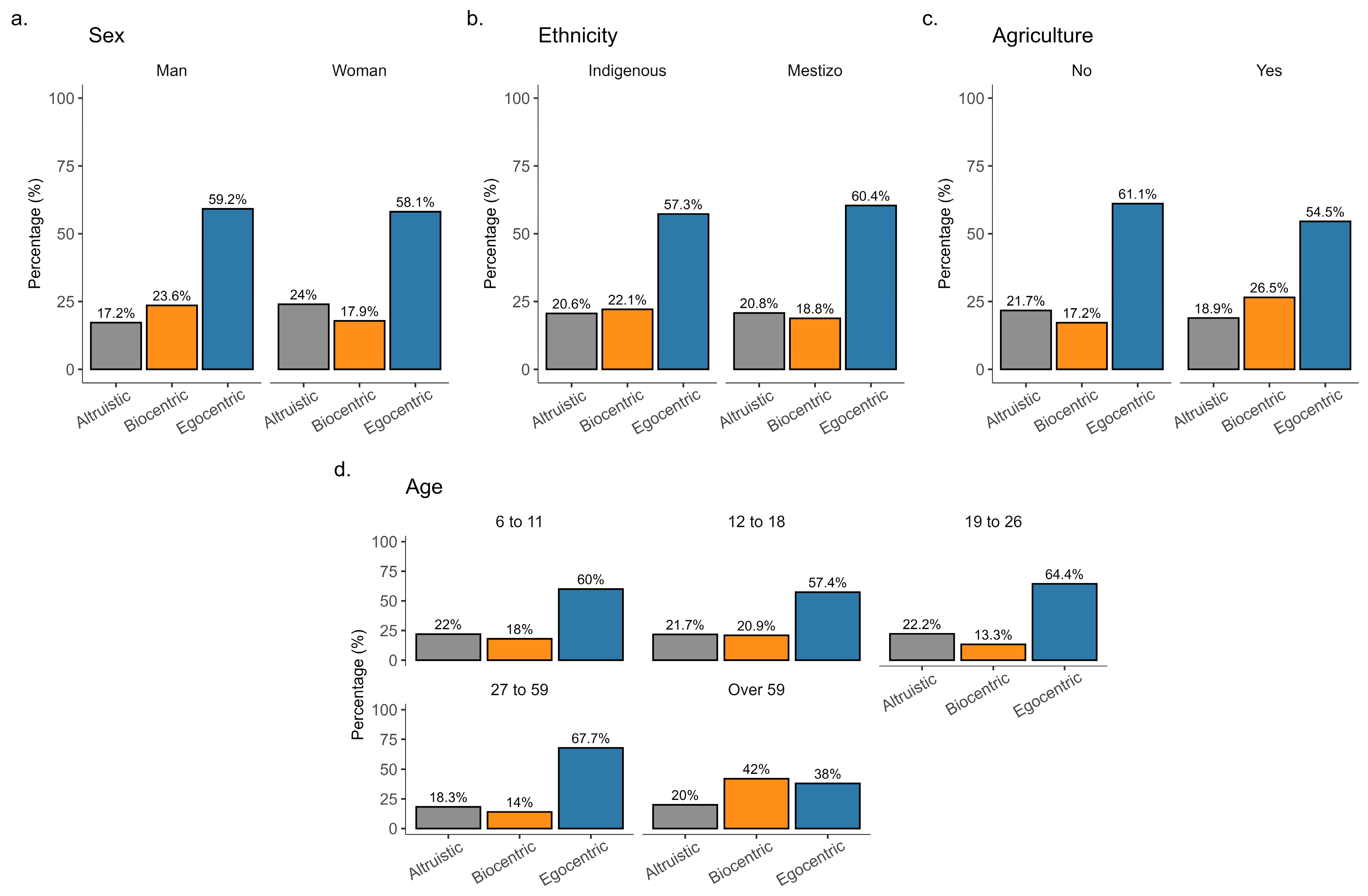
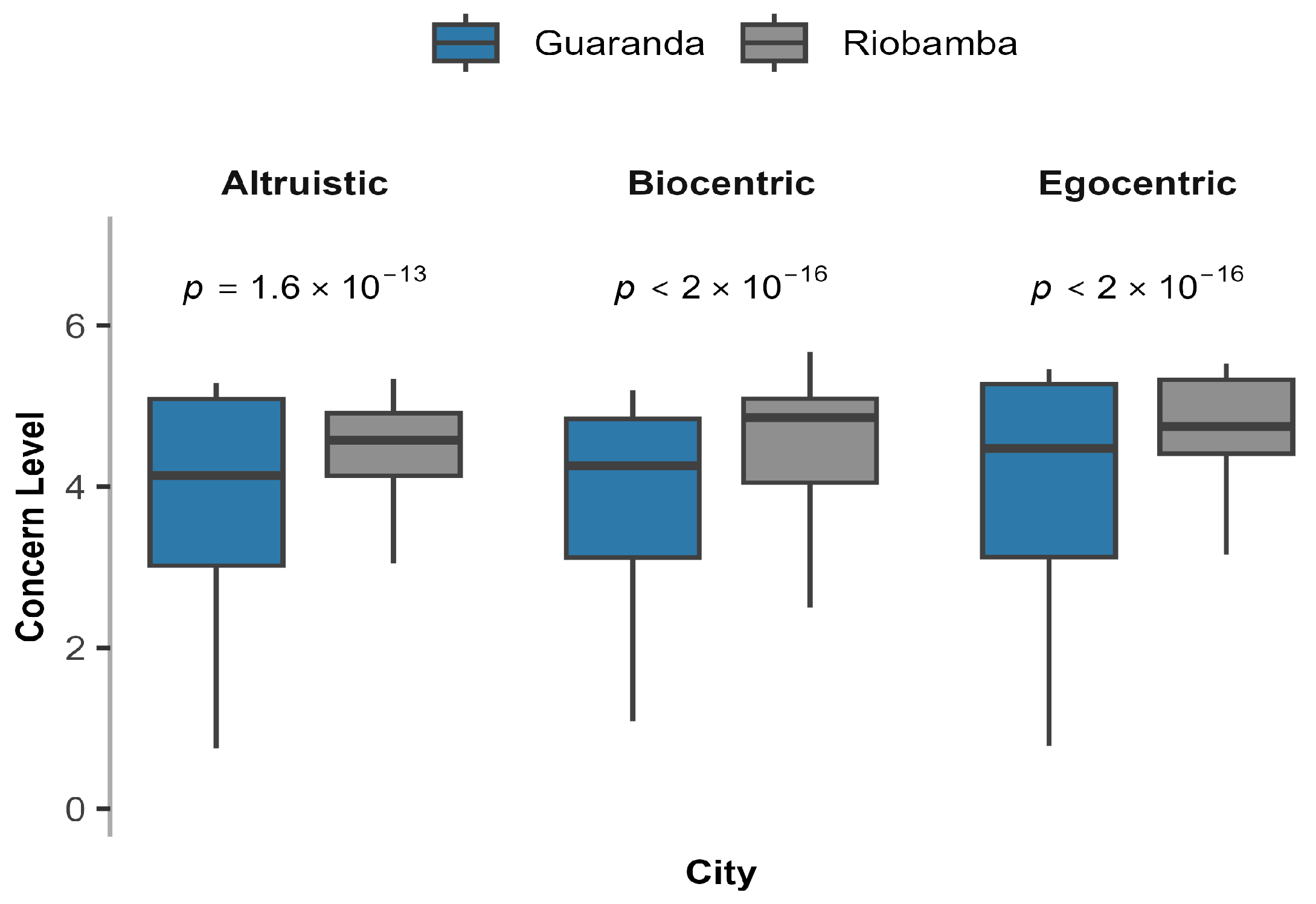
| Fit Index | Threshold | Interpretation | Reference |
|---|---|---|---|
| Comparative Fit Index (CFI) | >0.95 | Good fit | [35] |
| 0.90–0.95 | Acceptable fit | ||
| <0.90 | Poor fit | ||
| Tucker–Lewis Index (TLI) | >0.95 | Excellent fit | [36] |
| 0.90–0.95 | Acceptable fit | ||
| <0.90 | Poor fit | ||
| Root Mean Square Error of Approximation (RMSEA) | <0.05 | Optimal fit | [37] |
| 0.05–0.08 | Acceptable fit | ||
| 0.08–0.10 | Marginal | ||
| >0.10 | Poor fit | ||
| Standardized Root Mean Square Residual (SRMR) | <0.08 | Good fit | [38] |
| 0.08–0.10 | Marginal fit | ||
| >0.10 | Poor fit |
| Sociodemographic Characteristic | Guaranda (%) | Riobamba (%) | |
|---|---|---|---|
| Sex | Man | 49.34 | 46.74 |
| Woman | 50.66 | 53.26 | |
| Ethnic self-identification | Indigenous | 56.43 | 48.56 |
| Mestizo | 43.57 | 51.44 | |
| Age | Children | 14.17 | 9.40 |
| Adolescents | 32.55 | 15.14 | |
| Youth | 12.86 | 20.10 | |
| Adults | 26.25 | 41.25 | |
| Older adults | 14.17 | 14.10 | |
| Agricultural activity | Yes | 37.27 | 39.16 |
| No | 62.73 | 60.84 | |
| Independent Variable | Reference Category | EC | BC | AC | |||
|---|---|---|---|---|---|---|---|
| β | p | β | p | β | p | ||
| Sex | Man | −0.050 | 0.207 | −0.124 | 0.002 | −0.063 | 0.116 |
| Agriculture | No | −0.233 | <0.001 | −0.218 | <0.001 | −0.235 | <0.001 |
| Ethnicity | Indigenous | −0.013 | 0.754 | 0.022 | 0.572 | 0.007 | 0.868 |
| Childhood | Young Adult | −0.017 | 0.704 | −0.025 | 0.589 | −0.029 | 0.547 |
| Adolescence | 0.026 | 0.583 | 0.079 | 0.105 | 0.012 | 0.814 | |
| Youth | −0.017 | 0.729 | 0.011 | 0.836 | −0.008 | 0.863 | |
| OlderAdult | −0.068 | 0.171 | −0.028 | 0.554 | −0.054 | 0.262 | |
| City | Guaranda | 0.205 | <0.001 | 0.088 | 0.047 | 0.145 | 0.001 |
Disclaimer/Publisher’s Note: The statements, opinions and data contained in all publications are solely those of the individual author(s) and contributor(s) and not of MDPI and/or the editor(s). MDPI and/or the editor(s) disclaim responsibility for any injury to people or property resulting from any ideas, methods, instructions or products referred to in the content. |
© 2025 by the authors. Licensee MDPI, Basel, Switzerland. This article is an open access article distributed under the terms and conditions of the Creative Commons Attribution (CC BY) license (https://creativecommons.org/licenses/by/4.0/).
Share and Cite
Rivera-Velásquez, M.F.; Cóndor-Simbaña, C.G.; Lapo-Alcivar, C.M.; Viteri-Núñez, D.P.; Saigua-Pérez, V.S. Environmental Concern in Rural Andean Communities: Comparative Study in Central Ecuadorian Highlands. Sustainability 2025, 17, 5551. https://doi.org/10.3390/su17125551
Rivera-Velásquez MF, Cóndor-Simbaña CG, Lapo-Alcivar CM, Viteri-Núñez DP, Saigua-Pérez VS. Environmental Concern in Rural Andean Communities: Comparative Study in Central Ecuadorian Highlands. Sustainability. 2025; 17(12):5551. https://doi.org/10.3390/su17125551
Chicago/Turabian StyleRivera-Velásquez, María Fernanda, Cristina Gabriela Cóndor-Simbaña, Cristhian Mauricio Lapo-Alcivar, Diego Paul Viteri-Núñez, and Víctor Santiago Saigua-Pérez. 2025. "Environmental Concern in Rural Andean Communities: Comparative Study in Central Ecuadorian Highlands" Sustainability 17, no. 12: 5551. https://doi.org/10.3390/su17125551
APA StyleRivera-Velásquez, M. F., Cóndor-Simbaña, C. G., Lapo-Alcivar, C. M., Viteri-Núñez, D. P., & Saigua-Pérez, V. S. (2025). Environmental Concern in Rural Andean Communities: Comparative Study in Central Ecuadorian Highlands. Sustainability, 17(12), 5551. https://doi.org/10.3390/su17125551






